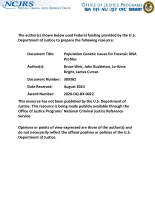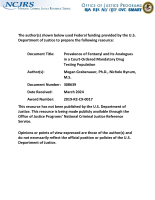Populations
What about us? Formative evaluation of forensic nursing program delivery of intimate partner violence medical forensic examinations
Population Genetic Issues for Forensic DNA Profiles - Draft Final Report, January 1, 2021 - June 30, 2023
Understanding the Impact of COVID-19 on Victim Services
The COVID-19 pandemic had a detrimental impact on communities across the nation and significantly affected various aspects of individuals’ lives. One of the negative impacts was an increase in gender-based violence accompanied by shifting barriers to accessing services and support. Victims and victim service providers faced various challenges dealing with the increase in need for services, navigating barriers to help-seeking, and addressing logistical issues.
See the YouTube Terms of Service and Google Privacy Policy
Prevalence of Fentanyl and Its Analogues in a Court-Ordered Mandatory Drug Testing Population
The Utility of Cranial and Dental Data in an Integrated Approach to Population Affinity
Incarceration and Desistance: Evidence from a Natural Policy Experiment
Detection and Characterization of Subpopulations and the Study of Algorithmic Bias in Forensic Identification of Source Problems
A Data-Informed Response to Emerging Drugs
The emerging drug crisis in the U.S. touches both criminal justice and public health, and experts from both fields came together at NIJ’s 2023 National Research Conference to discuss strategies and tools to fight this problem. Dr. Frances Scott, NIJ scientist and program manager, continues the conference discussion with two fellow panelists: Ciena Bayard, the Method Development and Validation Program Manager for D.C. Office of the Chief Medical Examiner, and Haley Greene, the Deputy Epidemiologist for the Central Region for the Virginia Department of Health. Read the transcript.





